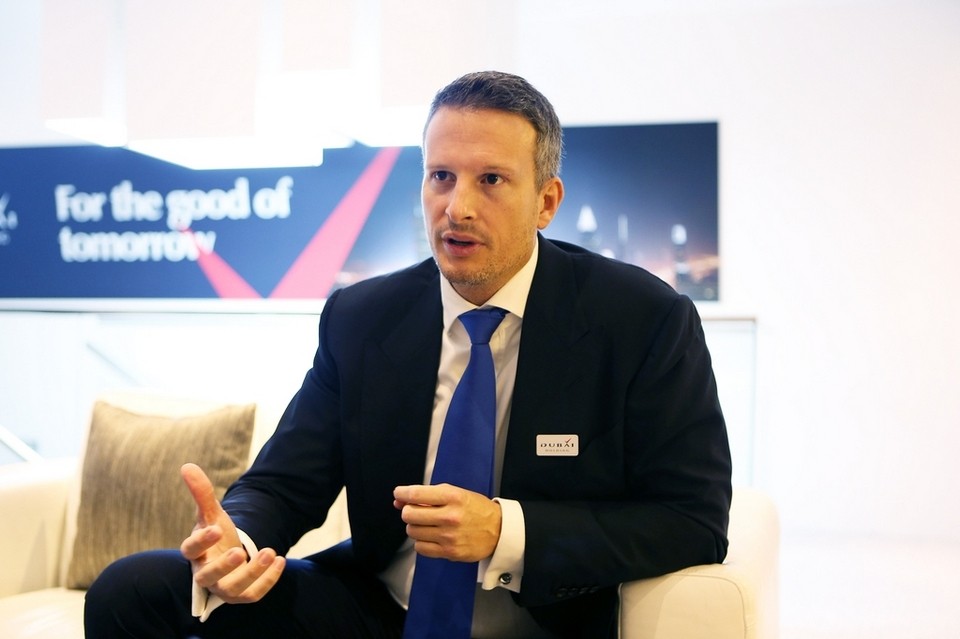
Morgan Parker, the new chief operating officer of Dubai Holding’s Dh25 billion Mall of the World project, was keen to stress during this month’s Cityscape that redeveloped plans for the site represent “an evolution”, not a revolution.
“Basically, the plan that was announced last year had in it all of the same components as we have now. The components have not changed.
“What has changed is the way in which we’ve been thinking about the development. If you just build 3.5 million square metres of stuff on the site in the way other developers do, we are going to contribute to congestion.”
He says the new plan is a “transport-led solution” with a more logical system for connecting to transport infrastructure. For instance, the Mall of the World plot is served by two existing Dubai Metro stations – Mall of the Emirates and Sharaf DG, but the site will have a transport hub that will link to three lines of the Dubai Tram – the existing Marina line, the spur towards Jumeirah and a new line that will be built towards Arabian Ranches. It will also house a bus station.
The main change, however, seems to be the insertion of a series of roads through the site, meaning it is less of a solid mass and more of a collection of tree-lined streets with a smattering of new parks.
Mr Parker, who has previously worked on the development of new cities in Asia such as Songdo in Korea, Yujiapu in China, Cibadek in Indonesia and Putra Jaya in Malaysia, says the new Mall of the World plan is based on “permeability and intuitive design”.
“One of the things I’ve noticed about Dubai is you can see a building but you can’t get to it a lot of the time. What we’re trying to do with this permeability is reduce the barriers. Why are we doing that? Well, it makes the world a nicer place to be in,” he says.
He adds that in Dubai there are “very prescribed movements”, meaning that journeys are made with a fixed destination in mind, such as one of the existing mega-malls.
“The problem with the site is that it’s right on Sheikh Zayed Road. Most people think, ‘Isn’t that great?’ but if you’ve ever been on Sheikh Zayed Road, it’s a barrier. People are going along there at 100km an hour and getting on and off it is problematic.”
He argued that the creation of wider, tree-lined boulevards allows luxury retailers to create favoured “maison” stores – stand-alone flagship properties within a neighbourhood of like-minded retailers that exist in Paris and in the Ginza neighbourhood in Tokyo.
“What’s exciting about retail flagships is they do that rarely. If we can create an environment where retailers are willing to build full, flagship maison stores it puts Dubai into a category of cities that is quite rare,” Mr Parker says.
“It would be the only such location in the whole of the Middle East where that occurs. So when people say to me, ‘what’s the next big thing in retail?’, it’s not going to be another Dubai Mall – although that’s great. It’s creating an environment for a new expression of retail.
“We believe tourism in the future is not going to be people looking at a big, tall building or a big mall. Once they’ve done that, they’ve done it. It’s about people coming in to hang out in a coffee shop or a park.”
Breaking down the area into different districts also allows for a more piecemeal approach to the development of such a major site, which will take years to build out. Mr Parker says Mall of the World is not one, but 75 different projects.
This also means it can begin by focusing its efforts for phase one on the 40 per cent of the site not occupied by Dubai’s Police Academy, which will stay on the remaining 60 per cent for another two years until its new facility is built.
When Dubai Holding initially announced the project 12 months ago, it said it expected to award tenders for the first phase in the first quarter of this year, with completion of phase one by the end of 2018. However, Mr Parker today declines to give any completion dates and says ground breaking is not likely to take place on site for 18 months.
“While everyone is waiting for us to ‘build, build, build’, there are real serious issues we are dealing with,” he says.
“In other parts of the world this would be billed as an urban renewal project. It’s not a greenfield project.”
He adds that urban renewal schemes offer “the greatest opportunity, because you’re changing the character of the city”, with the site moving from low-density use to a major, mixed-use centre.
“That change takes a few years to plan because it has implications on traffic systems. If we don’t get that change right, then I’m fearful of what the result can be.”
Janus Rostock, a design director of Atkins’ architecture and urban design division, says he believes much more thought is being put into the masterplanning and creation of new communities in Dubai nowadays.
“I think there is a lot of emphasis right now on quality of public urban space.
“There is a much larger focus on creating neighbourhoods that are walkable, where cars are less dominant,” he says.
“I think people are also recognising the identity that is coming out of the public realm and how important that is for the well-being of people and the marketability of developments themselves.
“If you look at some of the latest renders coming out from some of the big developers, it’s something that they are focusing on a lot,” says Mr Rostock.
“Previously, it was more about the buildings themselves, now it’s really about the network that is connecting them together.
“I think it’s a trend we have seen in other places around the world. If you think about a city you have been to, you remember the spaces rather than the individual buildings.”
He also says that in the long term, most of the new communities being created will be much more friendly towards both pedestrians and cyclists.
“What we have to remember is cycling here is still seen as a leisure activity rather than something that is bringing you to work. I’m from Copenhagen, where 50 per cent of all trips that are happening are on bicycles,” Mr Rostock says.
“Of course, there are opportunities to do things here differently. I’m not quite sure we are there yet but, having seen the transition that has happened in terms of pedestrians in the 10 years that I have been here, you might find in another 10 years that Dubai has significantly changed again.
“Dubai is quite good at adapting its strategies if they find something is catching on.”
David Godchaux, the chief executive of Core Savills, says there has been a growing preference from buyers to also be part of integrated communities that are connected by bicycles and walking routes as opposed to being dominated by cars.
“People like being connected to their neighbourhoods and being able to get around by walking from work to home or to shops as well,” he says.
He argues many Emiratis enjoy such benefits when they shop and stay in London, Paris or other parts of Europe and want the same experience at home.
Mr Godchaux also points to the success of Dubai’s City Walk scheme, which has stores on lower levels and apartments above as “probably the first time we have a real city shopping experience” within a purpose-built, mixed use scheme in recent years.
 Comments ( 0 )
Comments ( 0 )
 Post a Comment
Post a Comment